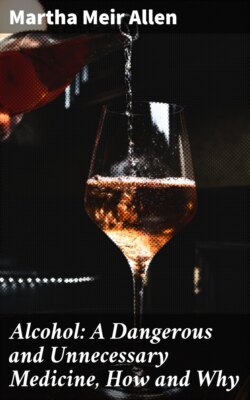Читать книгу Alcohol: A Dangerous and Unnecessary Medicine, How and Why - Martha Meir Allen - Страница 35
На сайте Литреса книга снята с продажи.
ALCOHOL IN OTHER HOSPITALS.
ОглавлениеIn the spring of 1909 a circular letter was sent to some of the best known hospitals throughout the country asking if the use of alcoholic liquors had decreased in those institutions during the past ten years. From the replies received the following statements are taken:
Cook County Hospital, Chicago, sent figures for two years only, 1907, and 1908. With 28,932 patients treated in 1907, the bill for wines and liquors amounted to only $719.40. In 1908 with 31,202 patients the bill for liquors amounted to $970.65. This makes a per capita expenditure for liquors for 1907 of .024 cents, and for 1908 a per capita expenditure of .031 cents. The per capita expenditure for liquors during the same years in Bellevue and Allied Hospitals of New York city, with from 30,000 to 40,000 patients treated was .0246 and .029. Two or three cents as the yearly per capita expenditure for alcoholic liquors in the two largest hospitals in America is striking evidence that the physicians practicing there have not large faith in whisky, or other alcoholic liquors as remedial agents.
Long Island, N. Y., State Hospital:—“We are not using more than half the amount of alcohol we used ten years ago.”
Manhattan State Hospital, Ward’s Island, New York City:—“Our patient population has averaged nearly 4,500 the last four years, and we have had about 750 employees, many of whom are prescribed for by institution physicians. The per capita cost of distilled liquors for the last fiscal year was .0273 at this hospital.”
Milwaukee City Hospital:—“No alcoholic liquors are used to any extent in this hospital, or prescribed by the staff. I know of no move against such use of liquors, but venture the assertion that the physicians believe they have more reliable agents at their command for most cases.”
Pennsylvania Hospital, Philadelphia:—“We are now using about one-third the amount of liquor that was used in the Pennsylvania Hospital ten years ago.”
The Presbyterian Hospital of Philadelphia sent figures for the years from 1900 to 1908. Those for 1900 show the cost of liquors to be $774.20 and for 1908 only $331.48. The number of patients was not given.
Grady Hospital, Atlanta, Georgia:—“That less liquor is now used than formerly is a fact well known to all connected with the institution.”
Garfield Memorial, Washington, D. C., sent figures for ten years. For 1899 the cost of liquors was $490.08, with a steady decrease to 1908 when the cost was $274.58. Number of patients in 1899 was 1,171; in 1908, 1,898 patients. The per capita for 1908 was .144 cents.
University Hospital, Ann Arbor, Michigan:—“Very little alcohol is prescribed in this hospital.”
Maine General Hospital, Portland:—“Comparatively speaking, we use but little alcohol for the reason that we now have many remedies which, especially for continued use, are superior to alcohol, which twenty years ago we did not have. For the conditions or emergencies in which we think alcohol has a value it is used when required or deemed best.”
Buffalo, New York, State Hospital sent figures for six years which include cost of alcohol used in the manufacture of pharmaceutical preparations, which, of course, makes a very decided difference. Per capita for 1903 was 22 cents; for 1908 it was 18 cents.
Buffalo, New York, General Hospital:—“The use of alcohol as a drug in this hospital has diminished about one-third in the past ten years, but I wish to add in this connection that the use of all drugs has diminished in this hospital, and to the best of my knowledge in other institutions of a like character. The use of the microscope, and other studies have advanced the science of medicine the same as all other branches of learning, and other methods are coming to be used beside the use of drugs.”
Mount Sinai, New York City:—“The use of alcoholic beverages here for medical purposes is the exception rather than the rule. The majority of our cases are surgical cases, and in these alcoholic liquors are rarely prescribed for any purpose whatsoever.”
Massachusetts Homeopathic Hospital, Boston, sent figures for five years. For 1904 the cost of alcoholic liquors was $197.69 with 3,720 patients; for 1908, the cost was $69.82 with 4,543 patients. The per capita cost for the five years is as follows: 1904, cost .0531 cents; 1905, cost .0474; 1906, cost .034; 1907, cost .0171; 1908, cost .0153.
In the Boston Medical and Surgical Journal of April 15, 1909, Dr. Richard C. Cabot gave a table showing the decrease in the use of alcoholic liquors, and of other drugs in Massachusetts General Hospital, Boston.
The following is his table:
